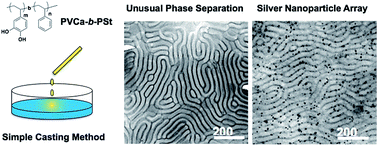Formation of unusual microphase-separated ultrathin films of poly(vinyl catechol-block-styrene) (PVCa-b-PSt) at the air–water interface by solution casting onto water†
Abstract
This report describes the preparation of ultrathin films possessing unusual fingerprint-like morphologies for poly(vinyl catechol-block-styrene) (PVCa-b-PSt) at the air–water interface by simply mixing a solution into water followed by solvent evaporation. Structural analysis and comparison with typical surface micelles of amphiphilic diblock copolymers indicated that precipitation and micelle aggregation played a significant role in the formation and unusual microphase separation of PVCa-b-PSt ultrathin films. In addition, the interior structures of the ultrathin films could be adjusted by adding homo-polystyrene (hPSt). Silver nanoparticle arrays were formed by immersing ultrathin films in aqueous AgNO3 and a microphase-separated structure in the ultrathin films could act as a template for the arrays.



 Please wait while we load your content...
Please wait while we load your content...